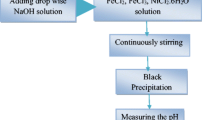Abstract
The effect of precipitating agent on the preparation of iron(III) oxide particles was investigated. Iron(III) oxide particles were prepared by precipitation of aqueous ferric nitrate solution by using ammonium acetate and ammonium hydroxide as precipitating agents. Particle size, shape, chemical composition, crystalline formation rate, crystallinity and magnetic property were measured for Fe2O3 particles obtained by precipitating with ammonium acetate, and compared with those of particles formed by using ammonium hydroxide. TGA, DTA, IR, XRD, TEM and VSM were used to characterize the particles. The nanoparticles synthesized with ammonium acetate showed a narrow size distribution, spherical shape, fast crystalline formation rate, high crystallinity and complete hysteresis loop. The better properties of particles formed by using ammonium acetate were originated from the chelating effect of carboxylate ions and higher crystallinity than those synthesized with ammonium hydroxide.
Similar content being viewed by others
References
Asai, S., Nakamura, H. and Konishi, Y.,“Kinetics of Absorption of Hydrogen Sulfide into Aqueous Fe(III) Solution,”Korean J. Chem. Eng.,14, 5 (1997).
Bee, A., Massart, R. and Neveu, S.,“Synthesis of Very Fine Maghemite Particles,”J. Magn. Mag. Mater.,149, 8(1995).
Brinker, C. J. and Scherer, G. W.,“Sol Gel Science,” Academic Press, San Diego (1990).
Carreno, T. G., Mifsud, A., Serna, C. J. and Palacios, J. M.,“Preparation of Homogeneous Zn/Co Mixed Oxides by Spray Pyrolysis,”Mater. Chem. Phys.,27, 287 (1991).
Frank, S. and Lauterbur, P. C.,“Voltage-Sensitive Magnetic Gels as Magnetic Resonance Monitoring Agent,”Nature,363,334 (1993).
Gunther, L.,“Quantum Tunneling of Magnetization,”Phys. World,12, 28 (1990).
Hu, Z., Fan, Y., Wu, Y., Yan, Q. and Chen, Y.,“Crystallization and Structure of High Boron Content Iron-boron Ultrafine Amorphous Alloy Particles,”J. Mater. Chem.,6,1041 (1996).
Ishikawa, T., Kataoka, S. and Kandori, K.,“The Influence of Carboxylate Ions on the Growth of Β-FeOOH Particles,”J. Mater. Sci.,28, 2693 (1993).
Kandori, K., Fukuoka, M. and Ishikawa, T.,“Effects of Citrate Ions on the Formation of Ferric Oxide Hydroxide Particles,”J. Mater. Sci.,26, 3313 (1991).
Kandori, K., Takeda, T. and Ishikawa, T.,“Effects of Amines on the Formation of Β-Ferric Oxide Hydroxide,”J. Mater. Sci.,27, 4531 (1992).
Mahan, M. and Mayers, J.,“University Chemistry,” Benjamin/Cummings, California (1987).
McMichael, R. D., Shull, R. D. and Swartzendruber, L. I.,“Magnetocaloric Effect in Superparamagnets,”J. Magn. Mag. Mater.,111, 29 (1992).
Nixon, L., Koval, C. A., Noble, R D. and Slaff, F. S.,“Preparation and Characterization of Novel Magnetite-Coated Ion-Exchange Particles,”Chem. Mater.,4, 177 (1992).
Prozorov, T., Databy, G. and Gedanken, A.,“Effect of Surfactant Concentration on the Size of Coated Ferromagnetic Nanoparticles,”Thin Solid Film,340, 191 (1999).
Roy, S., Das Sharma, A., Roy, S. N. and Maiti, H. S.,“Synthesis of YBa2Cu3O7-x Powder by Autoignition of Citrate-Nitrate Gel,”J. Mater. Res.,8, 2761 (1993).
Sun, Y. K., Oh, I. H. and Hong, S. A.,“Synthesis of Ultrafine LiCoO2 Powders by the Sol-Gel Method,”J. Mater. Sci.,31,3618 (1996).
Tronc, E., Belleville, P., Jolivet, J. P. and Livage, J.,“Transformation of Ferric Hydroxide into Spinel by Fe(II) Adsorption,”Langmuir,8, 313 (1992).
Yan, S. R., Jun, K. W., Hong, J. S., Lee, S. B., Choi, M. I. and Lee, K. W.,“Slurry-Phase CO2 Hydrogenation to Hydrocarbons over a Precipitated Fe-Cu-Al/K Catalyst: Investigation of Reaction Conditions,”Korean J. Chem. Eng.,16, 3 (1999).
Yue, Z., Zhou, J., Li, L. and Zhang, H.,“Synthesis of Nanocrystalline NiCuZn Ferrite Powders by Sol-Gel Auto-Combustion Method,”J. Magn. Mag. Mater.,208, 57 (2000).
Zhong, W., Ding, W. and Zhang, N.,“Key Step in Synthesis of Ultrafine BaFe12O19 by Sol-Gel Technique,”J. Magn. Mag. Mater,168,196 (1997).
Ziolo, R. F., Giannelis, E. P., Weinstein, B. A., Ohoro, M. P., Ganguly, B. N., Mehrotra, V., Russell, M. W. and Huffman, D. R.,“Matrix-Mediated Synthesis of Nanocrystalline γ-Fe2O3 ⊕ New Optically Transparent Magnetic Material,”Science,257, 219 (1992).
Author information
Authors and Affiliations
Corresponding author
Rights and permissions
About this article
Cite this article
Park, J.Y., Oh, S.G. & Ha, B.H. Characterization of iron(III) oxide nanoparticles prepared by using ammonium acetate as precipitating agent. Korean J. Chem. Eng. 18, 215–219 (2001). https://doi.org/10.1007/BF02698462
Received:
Accepted:
Issue Date:
DOI: https://doi.org/10.1007/BF02698462



